In the first part of her Portuguese journey, travel writer JEAN WEST finds a destination which veers from raw and wild to cultured and peaceful – but is never boring.
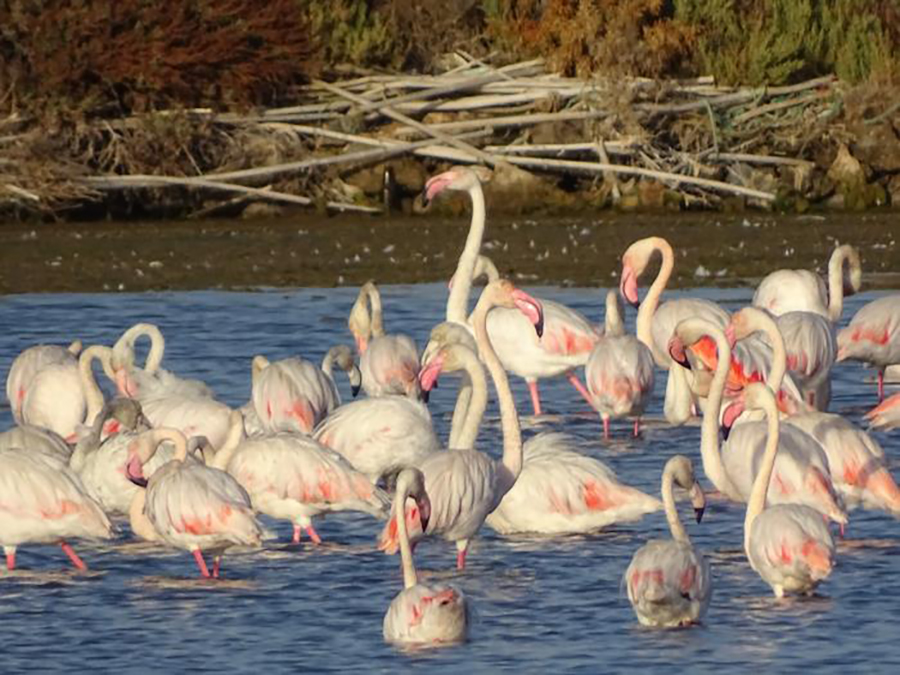
A SHIMMERING haze of pink flamingos in Europe….in March? A mirage, surely!
But, no, wait, I am not dreaming, I am wide awake – I know because the sun is burning my skin a similar hue to the salmon plumage of the exotic creatures just ahead of me.
I’m not in the Bahamas or some zoo in Key West. This is Portugal in the raw, a wild and colourful place, of nature reserves and forests, islands and rivers, palaces and peace.
It is 2pm and we are surfing the high tide on a small boat with Luiz of Costa Boat Tours, which runs frequent trips daily through the summer to get close to the unique birds, across a blue lagoon in the Ria Formosa, near the very lovely town of Tavira, in the south of a small nation with a big maritime history.
The flamingos are just one species of birdlife that opt to while away their springtime and summers in the waters of this spectacular natural park, which is constantly changing due to the fluctuation of winds, tide and currents, and embraces kilometres of white unspoilt, sandy beach.
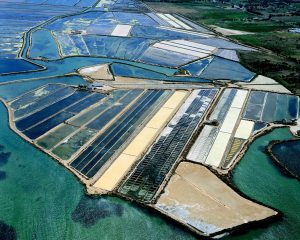
Here an array of birds from wader to razor bill, heron and stork, feed off the diverse flora and fauna thrown up by marshland, barrier islands, tidal flats, fresh water lagoons, salt pans, agriculture and woodland. We watch them with reverence.
There are dolphin too, which Costa Boat Tours also visit, and a family of orca whales apparently, just along the coast in the Western Algarve. Chameleon fade in and out of sight in the stubby brush and palm-dotted haven and, one of the largest populations of seahorse on the planet, use this as a breeding ground. Not unjustifiably has it been named a wetland of worldwide interest – a twitcher’s paradise to boot.
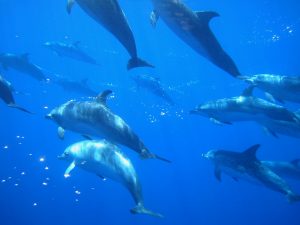
As winter tightened its grip and seized the UK’s spring sunshine, I determined to find some warmth along with those migrating and indigenous birds. A friend and I travelled by train from the southern tip of Portugal, to Lisbon, where that early globetrotter, Vasco da Gama headed out in search of the New World, and Porto, an enticing town of fishing boats and coffee houses.
The land of Fado and flamingo (a Portuguese word as it turns out, meaning flame-coloured), whose landmass clings to the side of Spain facing onto the Atlantic, is a rich dish to synthesise and savour and I am hungry to explore. The train trip from south to north is barely more than five hours. But by the end of it I am burning to return and catch more of the country’s endless possibility.
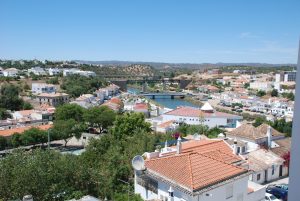
In Tavira (a surprisingly short skip from the fried egg and chips, sunburn and sand resorts of Albufeira, Lagos and Vilamoura, in the nightlife epicentre of the Algarve to the west) we sample a fusion of culture and cuisine, characteristic of this dreamy place, sculpted by invasion and dating back to prehistoric times.
The seafaring Phoenicians were the first to settle here and vestiges of their presence from around 800 BC are evident. Near the Convent of Graca, a Phoenician necropolis has been identified, where cremated corpses were deposited into ceramic urns.
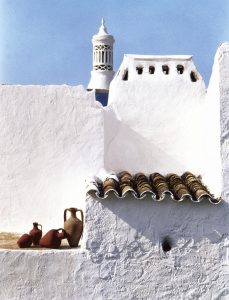
Every step through the cobbled city echoes keen heritage; we stare through the glass floor of Corte-Real Palace to witness the finds of an archaeological dig that has uncovered stone circles and altars for the worship of Baal, God of storm and thunder.
He is out of town rattling his sabre elsewhere now judging by the blue, blue sky and the bold flowering camellia, but the fisherfolk of this region have had plenty of truck with him over the centuries.
And then there is the ancient Roman city of Balsa, understood to have been larger than Lisbon during the Roman Empire, complete with its own coins. Discovered in 1866 by Portuguese archaeologist, Estacio de Veiga, it is believed to run for 47 hectares, encompassing urban and residential areas, cemeteries and fish salting factories.
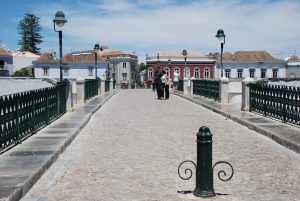
The Moors, Jews and Christians, further inspired the vibrant architecture, with its lattice working and bright tiling, intricate balconies, Renaissance and Baroque appeal; whilst a sizable lively market, sells fruit, flowers, vegetables fish and meat and – heaven of wonders – the custard tart, which, as we progress on our journey, becomes the ubiquitous snack.
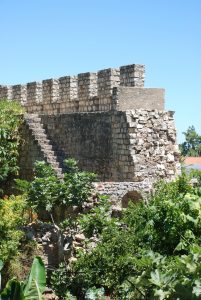
It is Easter and the 32 churches that litter the small city on the Gilão river, with its seven arched medieval bridge and castle, scented sweetly by a garden of oleander and bougainvillea, and commanding views of domes and red pan-tiled roofs, are gearing up for their traditional passion week parades.
We peep through their doors, some are decorated with the azuleja tiling, painted bright white and streaming with sunshine with golden altars, others hold morbid representations of the key religious players, at times, ghoulish, like tired, displaced shop dummies.
Shockwaves from the mighty Lisbon earthquake, one of the deadliest in history, that was felt as far off as Brazil and killed 100,000 people, when it struck on All Saints’ Day 1755, followed by a huge tsunami, are still evident here. Much of the castle was destroyed and some of the churches significantly damaged. But the stork nesting at eye level opposite on a phone mast seems unconcerned.
A dreamy dawn cycle on day three, through Tavira, past the pavement cafés and street musicians on Abilia bikes, hired for €8 per day, takes us through the octopus fishing village of Santa Luzia, where the sea creatures are caught by traditional method and smoked on charcoal in nearby restaurants. It’s an excellent way to start out as we yawn and stretch with nature, past the serene fishing boats bobbing in the harbour.
Meandering along the coast we take in scented meadows and orange blossom and emerge into full consciousness, infused with a sense of the wild. Lemon groves, heavy with their yield, almond and ancient olive trees, big fat daisies, magnolia, trumpeting orange nastertium and pink and violet blooms, cacti and pampas grass, blast us with colour before the first mile.
We arrive once more at Cabanas de Tavira, where the Gilao river drains into a lagoon in the Ria Formosa park; a protected area that houses the tourist village of Pedras D’el Rei. We had eaten here the night before, wowed by the rich flavours of simple cuisine.
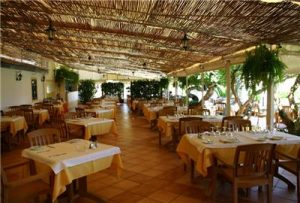
In a rustic setting, we devoured sumptuous sea bass and octopus so succulent and tasty we had seconds, and a surprise three-in-one layered cake: fig, cacao and almond, made from local produce. Paulo Marques, sales manager, treats us to a tour of the site, which embraces a former settlement of tuna fishers, now turned into a museum and café, on the staggeringly beautiful Barril Beach on Tavira Island, where bathers and more adventurous naturists can relax.
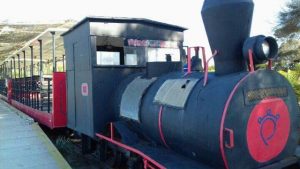
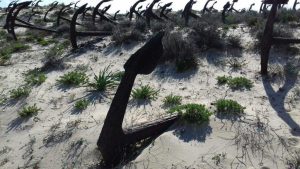
Not more than a handful of decades ago, a thriving tuna industry supported the economy, beginning in 1734, when the first huts arrived in the area, encouraging further settlement. This continued over the centuries before the Portuguese abandoned the pursuit, making way in the seventies for Japanese fishing ambition and tourism.
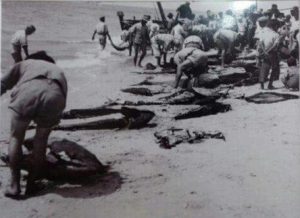
In 1885 some 47,000 tuna were harpooned in the coastal waters by brave but often impoverished fisher-folk, who lived, crammed together in brick houses with blood-stained floors, where the fish were gutted and prepared for sale. The community is still dedicated to at least some fishing.
Mr Marques’ family capitalised on the potential for ecotourism in the region half a century ago, long before it was fashionable, and is responsible for the complex, which offers self-contained apartments for short and long stay. They more recently financed a £500,000 bridge to link the mainland with the island, where there is space and freedom to roam on the pristine beaches.
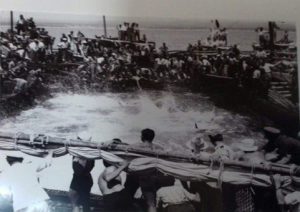
The year-round destination offers the opportunity for yoga, art, dance and painting, aside from the gripping tale of the tuna trade, so well-illustrated in the museum with stories and impressive photography of the men who braved the sea; nets, knives and harpoons at the ready to wrestle, the huge fish to submission.
Says Paulo: “The people lived very hard lives. The nets would be laid down for over four to five nautical miles. We are very glad that our old photographs are in black and white. The sea here would be blood red during fishing time.
“The fishermen lived in community,” he adds, pointing to an elderly bread oven in the wall. “There were a labyrinth of nets which were lifted by hand – women would make the nets but when there was a big haul, it was all hands on the deck.
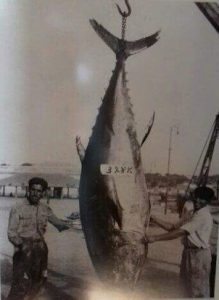
“It took up to 20 people to pull the nets inland. We would eat the whole of the tuna fish – even the bones and cheeks were used for stew. The good meat would be sold in Tavira and Villa Rial, where there were big factories. You can grill it or eat it, cut very thin raw with vinegar, red wine, onions and tomato.”
Tavira Island is widely regarded as one of best stretches of sand in Europe. In March a major sports festival is just about to take over its pretty, isolated shores and al fresco cafés, bars and shops have popped up. Beach Zumba and volleyball, body/mind/spirit endeavours and DJs on the beach energise the little haven before the season really kicks in.
Tearing ourselves away from Tavira, we head to Sintra, another minor world wonder acknowledged as such by UNESCO. Surrounding the resort town in the foothills of the Sintra mountains, the great and the good of recent centuries tried to outdo each other in awesomeness with pastel-hewed palaces and castles built in acres of phenomenal parkland and forest.
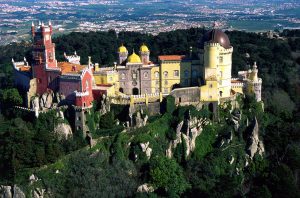
Moorish and Manueline strongholds contrast with real estate that might have interested Rapunzel numbering at least a dozen. I expect Bilbo Baggins or Merlin to shoot out from behind the curiously shaped trees and goblin green foliage and the many once residential structures that are straight out of Fantasia.
Indeed the biodiversity of this place is an act of natural wizardry. Sumptuous, mystic, romantic, mythic, poetic, elegant, grand, glorious; no number of superlatives can describe its architectural and bucolic richness.
After wrestling through the queue for buses – not fun, much like Windermere or Haworth Parsonage on a mental busy Bank Holiday – we opted for Palácio de Monserrate, built by English millionaire Frank Cooke in the 19th century, with its jaw-dropping botanical garden, ornamental lakes and exoticism.
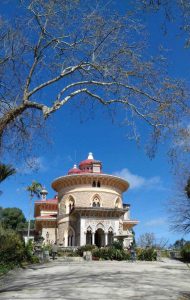
Here is a whopping slice of Eden. A Japanese and Mexican garden vie for attention with the fantastic Islam-inspired palace and its Arabian Nights turrets, exquisite carvings and Greek-style statues. Mighty golden carp swim in a nearby pond Monet would have choked on his paints over!
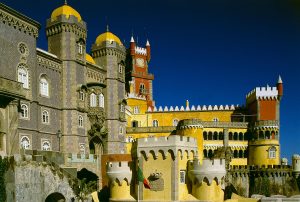
Palácio. Nacional da Pena, hidden in swathes of mist, atop flower-specked woodland and carved and topiaried gardens, is astonishingly elegant. Seated as it is in the heavens, it commands brilliant views and, on a sunny day, is no doubt spectacular. When we visit though, the rain lashes the hilltop and tears through the mostly alfresco design.
Hordes of tourists become snarled in a one-way snake through its many chambers. Ferdinand of Saxe Coburg Gotha’s project is stunning and interesting with its garlic shaped domes and yellow/pink palette, and no doubt is the best expression of 19th century romanticism in Europe, as it says, on the tin with its Meissen porcelain and Portuguese-style furnishings. But dripping wet after a major rain lashing the best bit for me was the warm tea and cake in a café outside that prepared us for our descent.
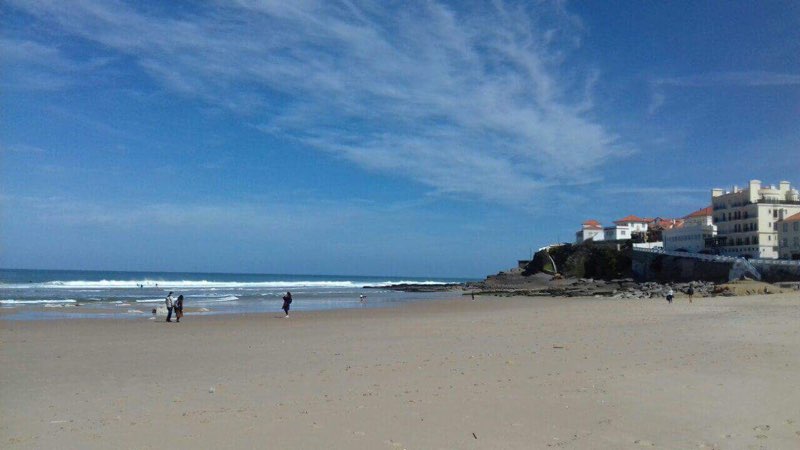
In contrast, the following day the sun bakes nearby Apple Beach as we head to the bluffs for some fresh air. The story has it that the river (Ribeira das Macas), once picked up autumn fruit from nearby orchards and took them bobbing to the sea.
It is a welcome outpost, facing out to the tempestuous Atlantic. High surf attracts adrenaline junkies whilst the sandy paths that cut through the cliff side, strewn with marine plants and flowers, conjures the Cornish Lizard trail.
On Easter Sunday, it is windswept and warm – we drink orange juice at a beachside fish restaurant that looks like it has been there forever. Fish swim in tanks and repose on our plates, and the whiff of barnacles and pirates is never far off as, tranquilised by the ozone, we contemplate our hike and later train commute to the capital, Lisbon.
